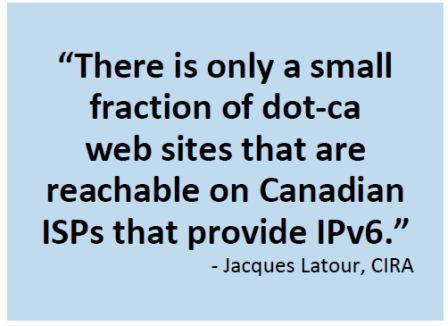
OTTAWA – The Internet is running out of space to handle a rapidly growing number of connected devices such as smartphones, tablets, gaming consoles, refrigerators, security cameras and other electronics.
The situation is so dire that regions such as the Asia Pacific have already run out of Internet addresses. Others such as Europe will see the “full” sign this fall. Even North America is expected to hit capacity next year with Canada anticipated to deplete all available Internet addresses in June 2013.
The only solution, according to speakers at an industry technical conference last week, is to adopt IPv6, a newer and more advanced addressing system that has the capacity to handle a considerably larger number of Internet-enabled devices than the old architecture.
The Internet’s current addressing system, referred to technically as IPv4, wasn’t designed to deal with a world where just about everything is connected to the Internet in some way, shape or form. While the explosion of mobile devices is largely culpable, other connected devices such as radio frequency identification (RFID) chips, smart electrical meters (they can send household electricity usage information directly back to the utility over wireless or wired networks) and even cloud computing are leading to the accelerating depletion of Internet addresses.
Last week at the International Conference on Communications in Ottawa, an event organized by the Institute of Electrical and Electronics Engineers (IEEE), Jacques Latour, director of IT at the Canadian Internet Registration Authority (CIRA), noted during a panel discussion that despite the urgency to adopt IPv6, Canadian ISPs are taking their time – too much time.
“We found that the Canadian ISPs are slow to adopt IPv6,” he said of CIRA’s experience in transitioning its own network and systems to the new Internet addressing architecture. They will do a custom order for an IPv6 network, as was done for CIRA, but progress is slow and being done a little at a time, Latour added

On June 6, which was World IPv6 Day, the number of Canadian web sites accessible by IPv6 increased by 500%, but in real numbers that’s only 10,000 sites out of 1.7 million. “There is only a small fraction of dot-ca web sites that are reachable on Canadian ISPs that provide IPv6. But this means we are starting to get some IPv6 in Canada,” said Latour.
Yves Pope, director of business development of IP strategy for India-based Tata Communications, explained that not only is IPv6 crucial for mobile, military and other public safety organizations will require the new Internet addressing system for their communications.
On the wireless front, some operators stepped into IPv6 early. Verizon is one such carrier that when deciding to launch LTE, it mandated IPv6 right from the start, said Pope.
The Canadian government has recognized the importance of transitioning its web sites and applications to IPv6. Serge Caron, senior director of information services and technology with the chief information officer branch at the Treasury Board Secretariat of Canada, described the federal government’s approach to the Internet-addressing problem during a 20-minute presentation.
He noted moving to IPv6 is no trivial exercise for an organization as large as the Canadian government. Not only does it have to upgrade networks, applications and facilities domestically, but it will have to do the same thing for its vast number of offices around the world. “For us as a global enterprise, it is important to ensure that we have the ability to offer our service in an uninterrupted way across the world. The notion of business continuity is very important to us,” he said.
The government has developed a three-pronged plan to get its house in IPv6 order. First, the enabling stage will see government departments and agencies prepare for IPv6. This is expected to be done by September 2013. The deployment phase is next, which is expected to be complete by March 2015, and will start with all front-facing applications. During the completion phase (beginning April 2015) the government will begin to work on enabling its internal network and systems for IPv6.



